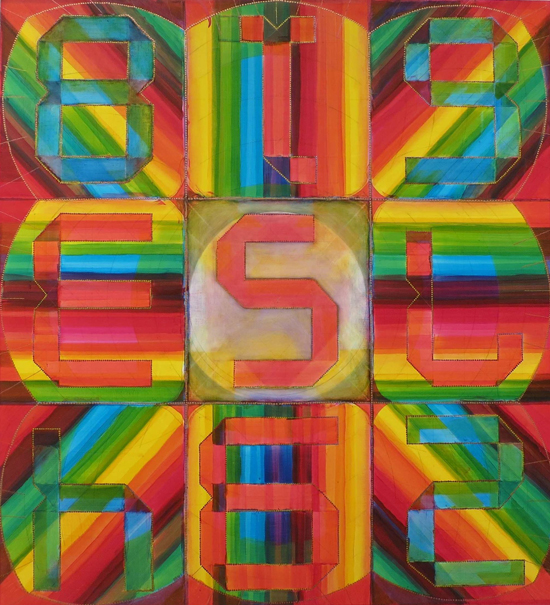Exploring the Spiritual Through Art
BUAG brings together painting, photography, sculpture, new media

December is for many a spiritual time of the year. With Hanukkah nearly over and Christmas just weeks away, it is a time for reflection. Elements, Rudiments, and Principles addresses the various ways that visual artists convey the spiritual. The new exhibition on view at the Boston University Art Gallery at the Stone Gallery is deeply personal and intimate.
The show includes work from 13 artists working in a variety of mediums: photography, painting, and sculpture. Some pieces more readily evoke the spiritual than others. Benny Merris’ photographs merge landscapes with the human form, suggesting the delicate balance between the human and natural world.
Xylor Jane’s colorful oil, pencil, and ink on wood canvases reveal her fascination with numbers. These bold works emphasize the order and rationality that numbers impose. And then there are Peter Coffin’s Aura Portraits, C-prints mounted on plexiglass, so ephemeral that they hint at the act of something being created—some gaseous substance taking shape. Hanna Sandin’s wonderful mixed media sculpture Untitled, made of everyday objects that the artist has reassembled to evoke something resembling a constellation, suggests a firmament where everything is in its place.

Perhaps the most overtly spiritual piece in the show is Sister Corita Kent’s Green Up, a serigraph made in 1966. Best known for her graphic Rainbow Swash, painted on a gas tank visible from Rt. I-93 in Dorchester, the serigraph is a series of words arranged backwards, asking: “When was the last time you saw a miracle?” Viewers cannot help but be startled by Kent’s painting. The question draws the viewer into an immediate dialogue with the work, and it’s difficult to walk away without attempting to answer the question.
Elements, Rudiments and Principles is the result of an ongoing conversation between BUAG director and chief curator Kate McNamara and Dana Frankfort, a College of Fine Arts assistant professor of visual arts. “We were both looking at and thinking about the parameters and structures that artists create to enable the creation of a material, a feeling, an idea,” McNamara says.

Viewers may be a bit hard-pressed to find the spiritual in Brian Belott’s playful representations of cats, Cat Diptych 1 and Cat Diptych 2, or in the partitions Heather Rowe uses in her architectural sculptures, like The Self, which in McNamara’s words “break up the process of looking through formal lines and perfected angles.” But, she notes, “the word spiritual is implied in both a literal and abstract application, and speaks to process as much as it does to subject matter.” So while Rowe’s sculptures may be simple in terms of the materials she uses, they “create incredible viewing mechanisms and play with the cinematic effects as the viewer engages” with them, McNamara says. And as for Belott’s cats, she urges visitors to take a closer look: “Belott’s cat paintings recall the careful, ritual, and ephemeral mandalas of Hindu and Buddhist practices.”
The arrangement of objects in this show has been carefully thought-out. The goal, says McNamara, was to “create a kind of spirit, a dialogue.” Viewers are meant to enjoy each piece not only on its own merits, but for the way it works with the others in the exhibition.
Elements, Rudiments, and Principles is on view at the Boston University Art Gallery at the Stone Gallery, 855 Commonwealth Ave., through December 20. Gallery hours are Tuesday through Friday, 11 a.m. to 5 p.m., Saturday and Sunday, 1 to 5 p.m.; the exhibition is free and open to the public.

Comments & Discussion
Boston University moderates comments to facilitate an informed, substantive, civil conversation. Abusive, profane, self-promotional, misleading, incoherent or off-topic comments will be rejected. Moderators are staffed during regular business hours (EST) and can only accept comments written in English. Statistics or facts must include a citation or a link to the citation.